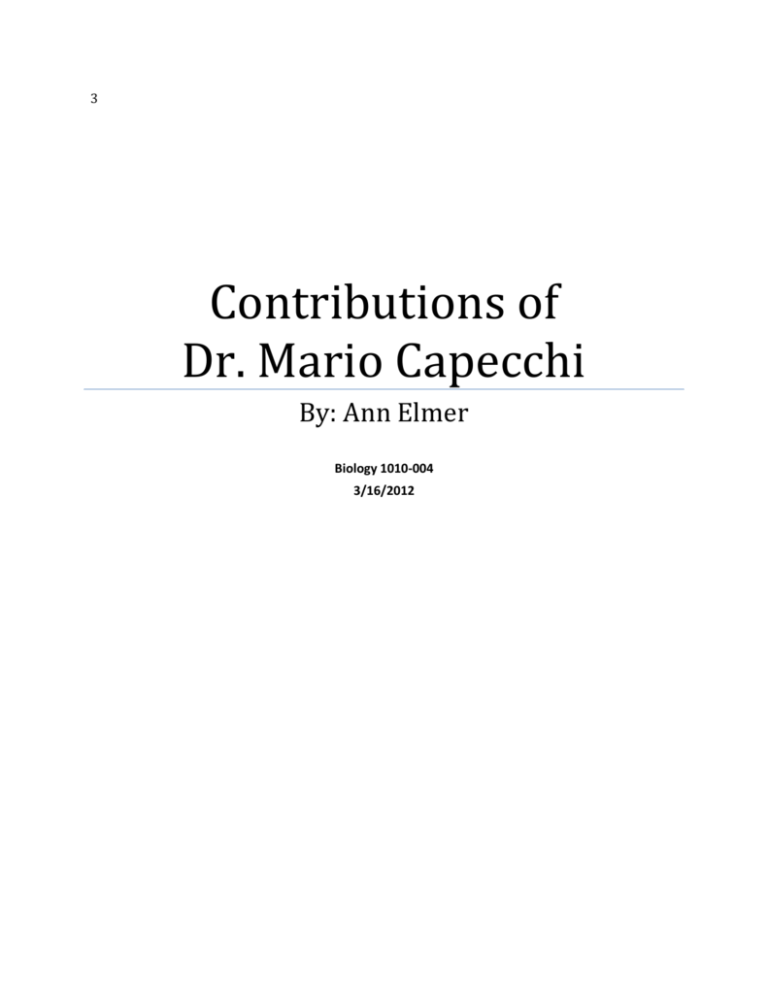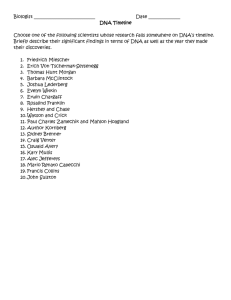Mario Capecchi Report
advertisement

3 Contributions of Dr. Mario Capecchi By: Ann Elmer Biology 1010-004 3/16/2012 On a beautiful, warm summer day in Utah, a few friends loaded up four wheeled allterrain vehicles (ATV’s) and headed for open space to enjoy a fun filled day. The morning was great with familiar trails and excitement. After lunch, with helmets on, the exploration went another direction. Slower speeds on unfamiliar territory did not prevent the devastating accident. A rider was thrown from his ATV and a spinal cord injury occurred. The active 25 year old became a paraplegic incapable of ever walking again. Spinal cord injury, diabetes, heart disease and many other ailments and diseases are scientifically reviewed with a vision that ailing organs and tissues might become repaired. This vision can become a reality. An important contributor to genetic advancement was Dr. Mario Capecchi. Born in Verona, Italy as a result of a passionate love affair between an officer in the Italian army and a beautiful poet, Capecchi had a troubled childhood. His parents were not married. His father was abusive and his mother was imprisoned as a political prisoner for five years. When Capecchi was just four years old, he was left to live on the on the streets of Italy. After his mother’s release, she found Capecchi in a hospital on his ninth birthday. After their reunification, they set sail to America. Upon arriving in America, Capecchi and his mother lived in Pennsylvania with his aunt and uncle, who was a brilliant physicist. Capecchi learned quickly and admits that academics came easily. He studied at Antioch College then earned a doctorate degree from Harvard University. Ultimately, he joined the University of Utah as part of a newly formed department with very talented scientists and high potential. Capecchi provides a message of hope as quoted from his autobiography, “The intrinsic drive to make a difference in our world is not easily quenched and that given an opportunity, early handicaps can be overcome and dreams achieved.” Capecchi’s achievements and contributions are many. He was part of the molecular biology revolution. He realized the most complex biological phenomena could be explained in molecular terms. He observed simple organisms that were mirrored in more complex ones and determined that genetics and molecular biology could be broken down into workable subunits. With his profound understanding of genetics, he established a way to inactivate targeted genes in mice embryo-derived stem cells, called “knocked-out” mice. Through successful breeding of “knocked- out” mice, gene functions and mutations can be studied. Currently, researchers throughout the world use this method. Further contributions include neural development in mammals, human genetic diseases, gene therapy, homologous recombination and programmed genomic rearrangements in the mouse. Dr. Capecchi was the recipient of the Noble Prize in Physiology or Medicine in 2007 for his “knocked-out” mice development. Other researchers were successful in getting cells to accept DNA fragments, however, the DNA was destroyed by enzymes in the cytoplasm. In about one in a million cells, the DNA reached the cell’s nucleus where it could be expressed. Capecchi realized the limiting barrier was getting the DNA into the nucleus, so he invented a needle that would provide an injection of DNA directly into the nucleus. This process presented another discovery called homologous recombination. In some cells, when DNA was injected, the DNA exchanged the related segment of DNA from the host cell. This means the injected DNA can replace the cell’s own gene. The study of genes was revolutionized with Capecchi’s discovery. Numerous subjects could be injected with a mutated DNA into a cell which provided researchers a way to determine the function of that specific gene and diseases associated with it. This process is called gene targeting and has benefited all types of life science. In the medical field, this was classified as a breakthrough discovery. If there is a defective cell, the DNA from a good cell can be replicated with the goal of replacing the imperfect cell. Continuing advancement of this theory brings hope to the spinal cord injured male from the ATV accident and many, many others with ailing genes. Instead of a confined life or eminent death, Dr. Capecchi’s contributions allow new life in the years to come. Bibliography "Autobiography." Mario R. Capecchi -. Web. 09 Mar. 2012. <http://www.nobelprize.org/nobel_prizes/medicine/laureates/2007/capecchi autobio.html>. "Dr. Mario Capecchi." Mario Capecchi Laboratory at the University of Utah. Web. 09 Mar. 2012. <http://capecchi.genetics.utah.edu/capecchi.html>. "HHMI: Nobel Laureates - Mario Capecchi." Howard Hughes Medical Institute. Web. 09 Mar. 2012. <http://www.hhmi.org/research/nobel/capecchi.html>. "Mario Renato Capecchi Mario Renato Capecchi." BookRags. BookRags. Web. 09 Mar. 2012. <http://www.bookrags.com/biography/mario-renato-capecchi-wog/>. "Related Websites." Neuroscience Program. Web. 09 Mar. 2012. <http://neuroscience.med.utah.edu/Faculty/Capecchi.html>. Reflection General education classes have undoubtedly broadened my academic perspective. The most influential classes for me have been in science. I feel science and biology have been the least appealing to take but the most beneficial in broadening my education. The challenge I found in preparing this report was to limit the information I learned. I selected Dr. Capecchi because he is a current biologist in Utah. What I realized with the research is that he overcame a difficult childhood and progressed to greatness. I found his autobiography intriguing and his insights profound. I appreciated his statement of hope and was inspired by his ambition to discover new information. As a non-traditional student, I realized there is so much to not only learn and apply but to contribute as well. Included in my goals of earning a degree, I hope my education and development can contribute to the lives of others also.








